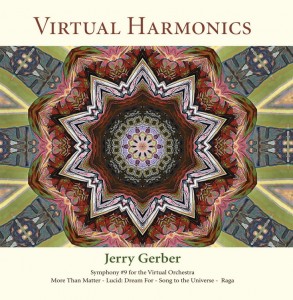 The art of “making music” in this digital age… When you really think about it, how incredible is it that as music-creators we can take something from our minds, and sculpt it into something tangible? No matter how novice or professional you are, no matter what others think or say about the music YOU create, there’s no denying that we are living in an incredible time of opportunity for crafting music.
The art of “making music” in this digital age… When you really think about it, how incredible is it that as music-creators we can take something from our minds, and sculpt it into something tangible? No matter how novice or professional you are, no matter what others think or say about the music YOU create, there’s no denying that we are living in an incredible time of opportunity for crafting music.
A while back I was introduced to a gentleman and composer working in SONAR out of Northern California by the name of Jerry Gerber. I knew he was a great composer from his accomplished list of credentials, but what I wasn’t prepared for was being absolutely fascinated by the sonic depth of “his sound,” the detail and integrity of his tracks, and moreover—how he accomplishes all of the above mentioned. When you listen to his work, and then hear his theoretic viewpoint of how to correctly compose and produce music, you quickly realize that this guy has tapped into something a bit deeper than most musicians.
What really made an impression on me was that without ever using the Piano Roll View (PRV), Jerry Gerber has composed and produced for some very highly-profiled films, television shows, computer games, concerts, dance and interactive media, and also back in the day wrote all of the original music for the remake of the popular children’s television show, The Adventures of Gumby. His approach to all this is through an expert level of “MIDI Sequencing” which he explains in the newest edition of the SONAR Newburyport eZine.
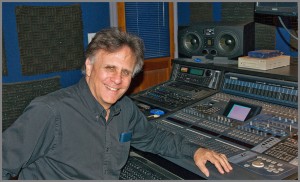 I was intrigued and beyond impressed by his words in the eZine, so I decided to [self-indulgently] dig a bit deeper by reaching out to Jerry to get some insight on his methods of madness with his new record. His words of musical wisdom make a lot of sense for anyone creating music in any genre, and I highly recommend the read; and then applying what you learn by analyzing and enjoying his new full-length composition.
I was intrigued and beyond impressed by his words in the eZine, so I decided to [self-indulgently] dig a bit deeper by reaching out to Jerry to get some insight on his methods of madness with his new record. His words of musical wisdom make a lot of sense for anyone creating music in any genre, and I highly recommend the read; and then applying what you learn by analyzing and enjoying his new full-length composition.
[Cakewalk]: You talked a lot about the “programming” aspect of the new record, but what was the “writing” process like for you?
[Jerry G]: Composing nowadays involves a two-step process: I do a lot of free improvisation on the piano, which generates ideas. Stravinsky once mentioned how important it is not to have “contempt for the fingers,” meaning, in my interpretation, that what our hands do spontaneously (governed by mind of course!) may be inherently musical and expressive and we should not necessarily throw that in the back seat for the sake of further abstraction. My improvisations involve no notation, no recording, nothing memorized—it’s the raw, spontaneous joy of making music and experiencing a sense of oneness with the sound, the closest analogy is meditation. I find that this process is a check on over-intellectualizing the composition process. When writing intricate music, it is tempting to come up with ideas that seem great, but don’t actually work well as sound. Music is about ideas and about sound. No matter how complex, clever or ingenious the ideas, they have to work as sound. Improv really helps to maintain that balance.
The 2nd step is going into the studio and composing. I open SONAR’s staff view and begin by popping notes onto the staff with the mouse. I generally begin with either a harmonic idea, a melodic idea, or even a tempo. There’s no one way to begin a piece. I think of composition as controlled spontaneity, part of the mind is feeling, sensing, imagining and listening (as in improv), the other part is involved in the technical processes of notation and sequencing. Before computers, I relied upon paper, pencil, piano and metronome. If someone would have told me 40 years ago I’d be producing symphonic music from my studio using computers and software in the not-too-distant future, I probably wouldn’t have believed them. While working on a piece I’ll sometimes print out a rough draft of the score and study it, but most of the composition process takes place in SONAR’s notation editor. I also use the event list a lot for inserting program changes and individual controller changes.
[Cakewalk]: Your new record is an amazingly balanced and tasteful bliss of intricate structure. What features and views in SONAR do you use technically and can you briefly share any examples of how the process flows in SONAR?
 [Jerry G]: Thanks! I spend most of my time in the staff view, the event list and the controller view while composing. After the composition is finished and the MIDI programming is complete, I render the MIDI data to audio and work with volume envelopes and signal processing. When writing orchestral music, I rarely play ideas into SONAR; I prefer to enter them via the mouse. There’s a lot of editing of note lengths, attack and release times, velocity and patch/articulation changes that need to be input, so it’s not faster for me to play the music via a musical keyboard.
[Jerry G]: Thanks! I spend most of my time in the staff view, the event list and the controller view while composing. After the composition is finished and the MIDI programming is complete, I render the MIDI data to audio and work with volume envelopes and signal processing. When writing orchestral music, I rarely play ideas into SONAR; I prefer to enter them via the mouse. There’s a lot of editing of note lengths, attack and release times, velocity and patch/articulation changes that need to be input, so it’s not faster for me to play the music via a musical keyboard.
[Cakewalk]: How does the programming for the percussion and drums work in your projects?
[Jerry G]: If I am using percussion from the VSL orchestral library I treat them as I do any instrument, creating a separate staff for timpani, snare, etc. If I am using a drum kit software plugin (I use EZ Drummer) I’ll create a groove in EZ Drummer and export it as a MIDI sequence into SONAR, placing the percussion pattern where it needs to go in the composition. It’s also not unusual for me to play percussion parts in via a music keyboard.
[Cakewalk]: What do you like about SONAR Platinum over the previous versions of SONAR?
[Jerry G]: No doubt, SONAR has made enormous progress over the past 3 years. When the X-series came out, I was frustrated, changing the ergonomics so drastically took quite a bit of time to iron out the bugs and get things working properly. By X3 I was warming up to the new look (I’ve used SONAR exclusively since Cakewalk for DOS, back in the early 1990s!). Platinum is really fine, the developers have fixed nearly all the problems plaguing the early X-series releases and have made many staff view improvements, which is important to me. SONAR’s signal flow is quite logical and I love the ergonomics of the latest Platinum release. I doubt there’s a better DAW on the market. Creating a DAW must be an incredibly complicated process. Some people think that by not using real players, I am being “anti-social” (orchestral conductors probably think this more than anyone), but in fact the developers of SONAR and the people who create the libraries and audio hardware—these are my unseen partners that support my creative work, so it hardly feels anti-social to me. So instead of working with conductors I work with semiconductors. ;>)
[Cakewalk]: What is next for you after releasing this record?
[Jerry G]: I’ve begun work on my 14th album, starting with some short piano pieces.
Click here to learn more about SONAR.
_____________________________________________________________________________________________________________
_____________________________________________________________________________________________________________
Anatomy of a SONAR Project: Virtual Harmonics
Composition and production with virtual orchestras are about much more than just playing notes—and the musical philosophies in this article apply to all forms of music
By Jerry Gerber
 A paradox of the medium in which I work is that though I receive sincere praise about the “realism” of my virtual orchestrations, my intent has never been to fool listeners into believing they’re hearing a recording of a live ensemble. Instead, my aim is to create music and recordings that are expressive, satisfying, and artistically effective as compositions and sound, using the medium of computer-based instruments. My art is a studio art, not a performance art in the traditional sense. Bringing MIDI performance values up to a high level of artistic expression requires that the composer understand composition and MIDI programming, and this understanding results from a long and deep commitment to the medium. As always the real work is in the details. The digital orchestra, like any artistic medium, has its strengths and weaknesses, its potential and its limits. I try to be cognizant of both as I work with new music possibilities.
A paradox of the medium in which I work is that though I receive sincere praise about the “realism” of my virtual orchestrations, my intent has never been to fool listeners into believing they’re hearing a recording of a live ensemble. Instead, my aim is to create music and recordings that are expressive, satisfying, and artistically effective as compositions and sound, using the medium of computer-based instruments. My art is a studio art, not a performance art in the traditional sense. Bringing MIDI performance values up to a high level of artistic expression requires that the composer understand composition and MIDI programming, and this understanding results from a long and deep commitment to the medium. As always the real work is in the details. The digital orchestra, like any artistic medium, has its strengths and weaknesses, its potential and its limits. I try to be cognizant of both as I work with new music possibilities.
My new CD Virtual Harmonics, a product of about two and a half years’ work, contains a new symphony for virtual instruments and four short pieces. One of the most joyous aspects of composing for its own sake, rather than as an adjunct to film, TV or games, is that the music itself determines the work’s content and form. This is both liberating and challenging; the piece expresses nothing but itself and the musical values and imagination of the composer.
Symphony #9 for the Virtual Orchestra is a four-movement, 34-minute work for virtual instruments, including orchestral samples from the Vienna Symphonic Library Orchestral Cube, software synthesizers including Tera, Massive FM8 and Z3TA, and choir samples from Requiem Pro. Each movement is designed around a few themes, sub-themes and motives, and the development proceeds from the economical use of these materials.
The 1st movement begins with double chromatic mediant harmonies in the divisi violins and divisi violas, setting the momentum and tension. Other primary material includes the horns at measure 3, the cellos at measures 10-11 and also at measures 32-33. There are also counter-motives in most of my symphonic movements. In this movement there are only orchestral samples, no vocals or synths.
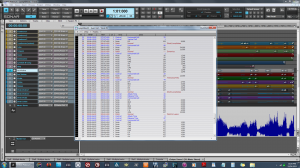 At least in my experience, structure evolves from content. The ideas themselves—where they want to go and how they get there—suggest and sometimes determine a piece’s form. I don’t start off with a pre-existing idea regarding overall structure, at least not consciously; I usually have an approximate length in mind, but even this depends on the ideas themselves, which are guided by subjective taste and aesthetic sensitivity. Freedom of imagination is the artist’s closest ally.
At least in my experience, structure evolves from content. The ideas themselves—where they want to go and how they get there—suggest and sometimes determine a piece’s form. I don’t start off with a pre-existing idea regarding overall structure, at least not consciously; I usually have an approximate length in mind, but even this depends on the ideas themselves, which are guided by subjective taste and aesthetic sensitivity. Freedom of imagination is the artist’s closest ally.
The second movement uses three instances of Z3TA+2, Cakewalk’s ingenious software synthesizer. I often play off arpeggiated rhythms and LFO-modulated timbres in my orchestrations; these dynamic harmonics can give clues as to how the orchestration, rhythm, and harmonies should proceed. The integration of orchestral samples and software synthesis is a natural starting point of exploration in this medium. Where virtual orchestration and traditional orchestration meet is often in specific ideas about the organization of timbre. Here are a few principles of orchestral writing to keep in mind.
Transparency: This implies that each musical part can be heard and has its own sonic space in which it can be heard. The ear rejoices in hearing chords sound together, but also in hearing each line as a thread in the tapestry of the musical texture. One meaning of transparency involves hearing a complex and dense passage with thick chords, while the linear polyphony is audible and the ear can follow a given instrument. This often requires eliminating all unnecessary notes and materials. As Brahms said, “It is not hard to compose, but it is wonderfully hard to let the superfluous notes fall under the table.” Often, what we omit from the composition defines its expressive power. The composer who doesn’t know the value of silence will not come to know the power in the notes. Transparency allows the music to breath, to allow space and silence to infuse their expressive qualities into the work.
 Orchestral Weight: This represents how many instruments are being assigned to a specific musical part. Other than true polyphonic texture, musical parts are often in a hierarchy of melodic and rhythmic importance. There are numerous hierarchies in music; intervallic, dynamic, rhythmic and temporal processes are in a constant state of change. In orchestral writing, the idea of the long-line is crucial because it is through a single melodic thread that the structures and ultimate shape of the piece unfolds. The ability to sustain the long-line is part of every good symphonist’s technique, whether writing for acoustic instruments or computer-based instruments. As Copland pointed out, it is one thing to write a successful 3- or 4-minute piece, another thing entirely to craft a much longer work that achieves unity, variety, cohesiveness, and both surprise and inevitability. The depth of thought and feeling a composer brings to a piece directly influences how techniques will be used, and while technique itself can be learned and practiced, desire, imagination and the will to write music is something a composer finds only within his own psychological, intellectual and emotional resources.
Orchestral Weight: This represents how many instruments are being assigned to a specific musical part. Other than true polyphonic texture, musical parts are often in a hierarchy of melodic and rhythmic importance. There are numerous hierarchies in music; intervallic, dynamic, rhythmic and temporal processes are in a constant state of change. In orchestral writing, the idea of the long-line is crucial because it is through a single melodic thread that the structures and ultimate shape of the piece unfolds. The ability to sustain the long-line is part of every good symphonist’s technique, whether writing for acoustic instruments or computer-based instruments. As Copland pointed out, it is one thing to write a successful 3- or 4-minute piece, another thing entirely to craft a much longer work that achieves unity, variety, cohesiveness, and both surprise and inevitability. The depth of thought and feeling a composer brings to a piece directly influences how techniques will be used, and while technique itself can be learned and practiced, desire, imagination and the will to write music is something a composer finds only within his own psychological, intellectual and emotional resources.
Orchestral Balance: Balancing the ensemble means that loud passages are not too loud, soft passages are not too soft, the transitions between them create the desired effect, and the composer is considering the four basic frequency ranges: Bass (20-200 Hz), low midrange (200-1000 Hz), high midrange (1000-5000 Hz), and high range (5000-20,000 Hz).
The ability to hear the subtle interaction of harmonics, the inner voices of a contrapuntal or homophonic texture, and the difference between very slight increases and decreases of volume (1 dB and less), is a necessary skill. Mastering engineer Bob Katz says that mixing at around 83 dB is a very good idea because mixing at too loud a level overemphasizes the lowest and highest notes, while mixing at too soft a volume risks the temptation to bring up the bass and high notes too much, which throws the mix out of balance. There’s a huge subjective component at work, because musical style often sets the bar as to how a mix should proceed.
Another example of balance is about ensuring that the orchestration isn’t cluttered with instruments that don’t add to the desired tonal color of the mix, or the music’s overall sonic impression. We must always consider the principles learned in the study of harmony, counterpoint and orchestration in context—every musical situation is different. Even in the same piece, the musical experience must exist within the flow of time. Theory may be a starting point in composition, but sooner or later intuition, imagination and the need to experiment drives the ultimate shape of the work.
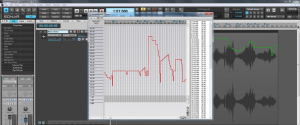 In the symphony’s 3rd movement, I programmed choir samples from the Requiem Pro library. Sometimes the voices are in front singing the primary line; other times, they blend into the orchestral texture. Achieving syllabic variation occurs via a MIDI controller, and adjusting volumes with controllers 7 or 11. Writing an adagio is challenging because a slow piece should not feel like it’s moving about aimlessly and slowly, but should have direction and momentum, even if very subtle. By examining the tempo map to this movement you’ll see there are many tempo changes, which enhance the musical flow and maintain the sense of direction.
In the symphony’s 3rd movement, I programmed choir samples from the Requiem Pro library. Sometimes the voices are in front singing the primary line; other times, they blend into the orchestral texture. Achieving syllabic variation occurs via a MIDI controller, and adjusting volumes with controllers 7 or 11. Writing an adagio is challenging because a slow piece should not feel like it’s moving about aimlessly and slowly, but should have direction and momentum, even if very subtle. By examining the tempo map to this movement you’ll see there are many tempo changes, which enhance the musical flow and maintain the sense of direction.
The 4th movement makes use of various software synthesizers, more than the other movements. It makes use of pedal points and counterpoint and is based on only a few melodic ideas and motives. The violins at the opening measures (m1-m25) might be considered the main theme and there are sub-themes that occur throughout the piece. I also use a variety of percussion in this movement, including snare, tambourine, cymbals, gong, harp and a complete drum kit from EZ Drummer’s software.
I can’t stress enough the importance of MIDI controllers. Phrase-shaping is critical to crafting a musical line with variations in dynamics, velocity, note length, location relative to the beat, attack and release time, and sample-switching. As illustrated in the event list in my compositions, a lot of programming goes into effective phrase-shaping; it’s not just a matter of choosing the right articulation, because that’s only the first step. Depending on the dynamics, tempo, and orchestral factors, sometimes deep programming is necessary to create a line that has fluidity, expression, naturalness and a sense of intention that comes with attention to detail. This is why composing and producing in this medium can take lots of time—the composer isn’t just writing the music, but also interpreting the music through programming and mixing.
I assign controller 18 to attack time and controller 19 to release time, as these are the two ADSR envelope components I use the most. Creating a smooth legato line, particularly in the strings, often requires attack and release adjustments in addition to choosing the best sample-set for the passage. Velocity is another component of phrase-shaping. The emphasis on strong and weak beats is necessary to overcome the sense of mechanicalness which always degrades musical expression, which is the opposite of intention. The precision by which the computer can perform music is only a liability when the musician doesn’t understand phrasing. We can introduce “conscious randomness” through various means, including variation in tempo, with strong and weak beats, by displacing notes slightly before or after the beat, and, with VSL’s software player, attack pitch.
Sometimes I’ll use a sample-set built on three trumpets; in other words the sample-set is a recording of three trumpet players. A unison line employing such samples will sound fuller than a recording of just one trumpet player. Other times I’ll write for three independent trumpets (let’s say they’re playing the same line in unison) and offset them both in time, by several milliseconds, and by pitch, detuning them by 5 or 10 cents or so. This creates a chorus effect that adds depth, complexity and variation to the sound. A sample-set can consist of thousands of samples—every note is sampled in numerous playing styles and numerous dynamic levels.
When I use reverb, I use one reverb for the entire piece. A mastering engineer once suggested that I use one reverb for the winds, one for the brass, one for the percussion and one for the strings. I tried this for a while, but didn’t like the sound because I heard it as weakening the cohesiveness of the space. Using one high-quality reverb (I use the Yamaha SPX-2000) allows for greater connection among the sections, and then I can apply a specific amount of reverb to each section. With instrumental music, I generally record the final wave file in stereo with reverb.
After I’m satisfied that the composition is finished, I then check the MIDI sequence for errors. I export the file into Sibelius and create the score, even though live players are not involved, because the score helps me find mistakes, miscalculations and other issues that I may have overlooked while composing; allows discussing my work with students; and if I publish the piece for players I can add the necessary breathing, phrasing, bowing, dynamic and articulation marks so the piece can be played by musicians
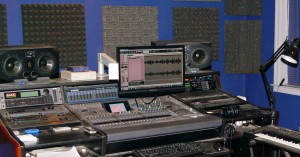 Another important creative purpose of a musical score is that it brings a second sense, the visual, to the process of composition. Though it’s obvious that the way music sounds is far more important than the way it looks on the page, notation allows the composer to consider the orchestration, harmonies, counterpoint, structure and textures of the piece in high-level detail. However, I don’t put details in the written score that instruct players how to play a given passage. Because this information is programmed abundantly in the MIDI sequence, and since there are no players, there’s no real reason to include these markings. The great power of notated rhythms are their potential for intricacy, precision and detail, the downside being only if they’re interpreted and performed without gesture, expression and intention. Notation allows for greater control of complexity and contrapuntal processes—something that overdubbing tracks doesn’t achieve to the same degree.
Another important creative purpose of a musical score is that it brings a second sense, the visual, to the process of composition. Though it’s obvious that the way music sounds is far more important than the way it looks on the page, notation allows the composer to consider the orchestration, harmonies, counterpoint, structure and textures of the piece in high-level detail. However, I don’t put details in the written score that instruct players how to play a given passage. Because this information is programmed abundantly in the MIDI sequence, and since there are no players, there’s no real reason to include these markings. The great power of notated rhythms are their potential for intricacy, precision and detail, the downside being only if they’re interpreted and performed without gesture, expression and intention. Notation allows for greater control of complexity and contrapuntal processes—something that overdubbing tracks doesn’t achieve to the same degree.
After finishing the score, the next step is rendering the MIDI performance into a wave file. I generally create a stereo wave file; stems are unnecessary at this point if the MIDI sequence was programmed with sufficient care. If I’m working with singers or instrumentalists, I make stems as well. The final wave file uses volume envelopes, which I think of as the macro-level of dynamics. Here the composer takes off the “composition” hat and puts on the “conductor” hat (or mastering hat if you prefer), and works with the overall volume of a piece’s various sections. Rather than use compression, volume envelopes on the stereo wave file accomplish a similar goal and with a high degree of precision. I use Ozone 5 for mastering, and often apply EQ, stereo imaging and a small amount of harmonic exciter to the music. I take my time and give myself a few days or even a few weeks or months to get used to the mix. If I’m not satisfied I redo the signal processing until I feel I’ve achieved the best results possible. I don’t consider the project complete until I burn the final master and send it off to the duplicator.
Jerry Gerber has written orchestral and chamber music, songs, piano music, vocal music and music for electronic instruments. He received his Bachelor of Music in composition and classical music theory from San Francisco State University in 1982 and has composed for film, television, computer games, concerts, dance and interactive media.
Virtual Harmonics is available on iTunes and also from jerry@jerrygerber.com for $16.76 via PayPal, which includes a weblink to the symphony’s score. You can also preview two tracks from the CD, as well as see their scores.
This article was republished and adapted with the express written consent of SoundBytes magazine.

